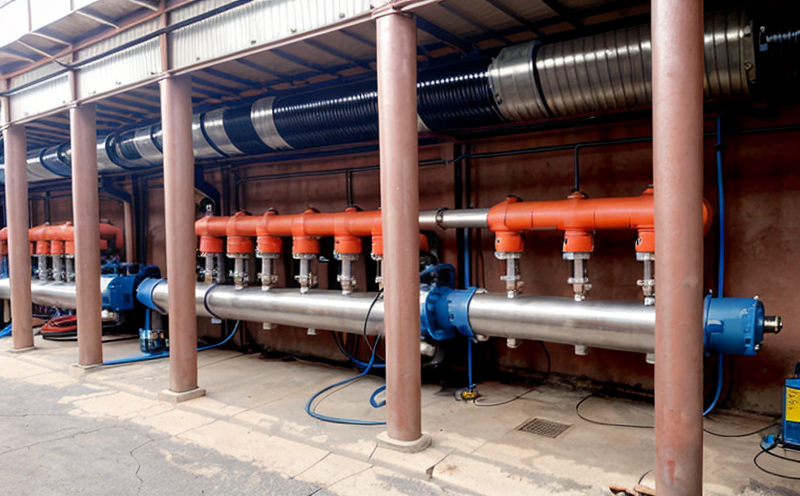Pneumatic system safety inspection
Ensuring the safe operation of pneumatic systems is crucial in industries where compressed air and gases are used. These systems are found across various sectors, including manufacturing, healthcare, and automotive, due to their versatility and efficiency. A pneumatic system safety inspection involves a comprehensive evaluation aimed at identifying potential risks and ensuring compliance with relevant standards and regulations.
The primary goal of this service is to safeguard personnel and equipment by detecting any faults or anomalies in the pneumatic systems that could lead to accidents or malfunctions. This includes checking for leaks, ensuring proper connection points, verifying the integrity of pressure vessels, and assessing overall system performance. By conducting these inspections, we help our clients maintain a safe working environment while complying with international standards such as ISO 8415:2003 and ASME PTC 19.1.
During an inspection, our team uses advanced tools and techniques tailored to the specific type of pneumatic system being evaluated. This may involve visual inspections, pressure testing, leak detection using tracers like helium, and temperature monitoring to ensure that all components are functioning within safe parameters. Our experienced technicians will provide detailed reports highlighting any issues found during the inspection process, along with recommendations for corrective actions.
Our approach is designed to be thorough yet efficient, allowing us to complete inspections quickly without compromising on quality or accuracy. By leveraging our expertise and state-of-the-art equipment, we can ensure that your pneumatic systems meet both industry requirements and internal expectations.
Applied Standards
The inspection of pneumatic systems is governed by several international standards aimed at ensuring safety and reliability. Some key documents include:
- ISO 8415:2003 – This standard provides guidelines for the design, installation, operation, maintenance, and testing of pneumatic systems.
- ASME PTC 19.1 – Developed by the American Society of Mechanical Engineers, this specification covers the selection, design, construction, inspection, testing, and operation of compressed air piping systems.
- BV 704:2016 – This French standard specifies requirements for the installation, maintenance, and use of pneumatic equipment in industrial environments.
By adhering to these standards during our inspections, we ensure that your pneumatic systems meet not only regulatory requirements but also best practices within the industry. Our team stays updated with any changes or updates to these documents so you can rest assured that every aspect of your system is being addressed comprehensively.
Scope and Methodology
The scope of a pneumatic system safety inspection encompasses multiple critical areas that need to be evaluated meticulously. Our methodology focuses on several key aspects:
- Visual Inspection: This involves checking all visible parts of the system for signs of wear, damage, or misalignment.
- Pressure Testing: We apply controlled pressure within safe limits to identify any leaks or weak points in the system.
- Leak Detection Using Helium Tracers: This advanced technique helps pinpoint even small leaks that might otherwise go unnoticed.
- Temperature Monitoring: Ensuring all components operate within acceptable temperature ranges prevents overheating and potential failures.
- Component Integrity Checks: Verifying the structural integrity of pressure vessels, valves, and other critical parts is essential for preventing catastrophic failures.
In addition to these technical evaluations, we also review documentation related to the system’s history, maintenance records, and any previous inspection reports. This holistic approach ensures that no detail is overlooked during our inspections.
Industry Applications
Pneumatic systems are integral to numerous industries where precise control over airflow or gas flow is required. Here are some examples of how this service can benefit different sectors:
- Manufacturing Plants: In automotive manufacturing, for instance, pneumatic tools like riveters and brakes play a vital role in production processes. Regular inspections help maintain optimal performance and prevent accidents.
- Hospitality & Healthcare: Hospitals rely heavily on pneumatic systems for tasks such as delivering medications or maintaining life support equipment. Ensuring these systems are safe is paramount to patient care.
- Automotive Repair Shops: Mechanics use compressed air for various tasks, including cleaning parts and operating tools. Safe installations reduce the risk of injury during repairs.
- Construction Sites: Portable compressors power many essential tools on construction sites. Proper inspection ensures they remain reliable throughout long hours of work.
Each application demands specific considerations when conducting inspections, but our approach remains consistent across all sectors – prioritizing safety and compliance with relevant standards.





